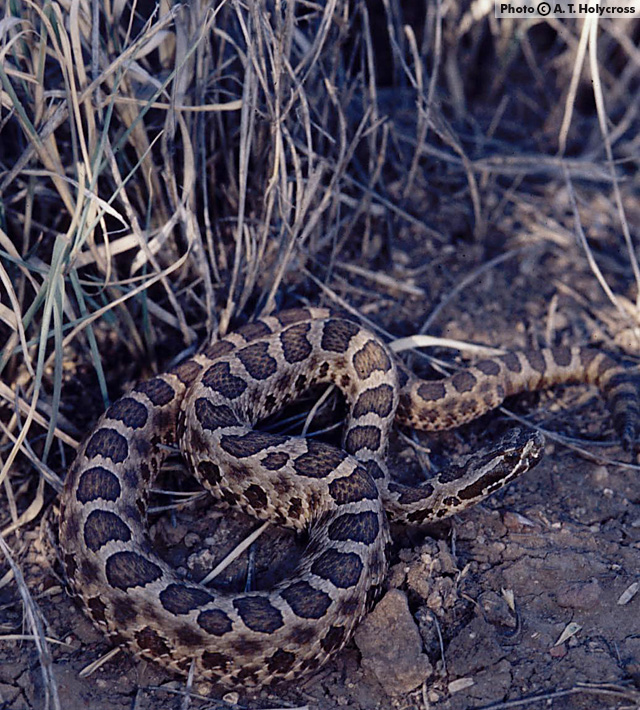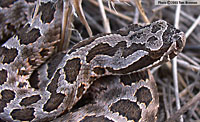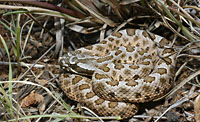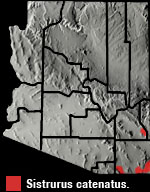Online Field Guide to The Reptiles and Amphibians of Arizona



Cochise County, AZ
 Cochise Co., AZ |
| MASSASAUGA Sistrurus catenatus |
Venomous
|
| DESCRIPTION: A small (up to 550 mm or 22″ in total length excluding rattle) light silver-gray to gray-brown rattlesnake. Large, oval, crisp-edged, dark brown blotches line the back. A row of faded, soft-edged blotches lines each side. Below that row there are two additional rows of crisp-edged, dark gray-brown blotches. A crisp dark brown bar bordered by a thin white lower-edge extends back from each eye. The top of the head is marked with two wavy, dark brown, elongated blotches that extend back onto the neck. Young have a yellow tail that is used to lure lizards. The underside is usually plain cream or white. The top of the head is armored with large plate-like scales. The pupils are vertically elliptical and the dorsal scales are keeled. The neck is slender and the head is broad and triangular. On the end of the tail is a rattle composed of a series of loosely interlocking keratinous sections. A new section is added each time the snake sheds its skin. The rattle is very small relative to the body size.
DISTRIBUTION: This snake’s range appears to be shrinking in Arizona. Some historic Arizona populations are likely extirpated. The species remains in only a few isolated populations in the extreme southeastern portion of the state. In Arizona it is found at elevations ranging from about 3,500′ to about 4,600′. HABITAT: In Arizona this snake is found in valleys, on low sloping bajadas, and on rolling grass-covered hills within the Semidesert Grassland community. DIET: The Massasauga eats lizards, centipedes, mice, and other small mammals. It uses venom injected through long, hollow, retractable fangs to kill and begin digesting its prey. REPRODUCTION: A litter of 4 to 8 young is born in late summer. REMARKS: This rattlesnake is capable of delivering potent venom. If encountered it should be left alone. A large percentage of envenomations occur when a snake is handled or abused. Protected in the state of Arizona. It is against Arizona State law to harass, harm, pursue, hunt, shoot, wound, kill, trap, capture, or collect this animal or to attempt to engage in any such conduct. Bartlett. 2000. Snakes of North America: Western Brennan, T. C., and A. T. Holycross. 2006. A Field Guide to Amphibians and Reptiles in Arizona. Arizona Game and Fish Department. Phoenix, AZ Degenhardt, W. G., Painter, C. W., and Price, A. H.. 1996. Amphibians and Reptiles of New Mexico. University of New Mexico Press. Albuquerque. Fowlie. 1965. The Snakes of Arizona. Azul Quinta Press, Fallbrook, California Lowe, Schwalbe, Johnson. 1986. The Venomous Reptiles of Arizona. Nongame Branch Stebbins. 1985. Western Reptiles and Amphibians. Houghton Mifflin. New York, NY |
|
Visit Partners in Amphibian and Reptile Conservation:


HOME
Copyright © 2023, Arizona Game and Fish Department. All rights reserved.
If you make use of the textual contents of this site in reports, publications, etc. please cite and credit the author(s) and photographer(s). All photos on this website are copyrighted. However, those found in the species account section may be used for any noncommercial scientific, educational, or conservation purposes provided that photographs are not altered and continue to bear the copyright symbol and name of the photographer. Please contact the photographer regarding commercial use of copyrighted photographs.












